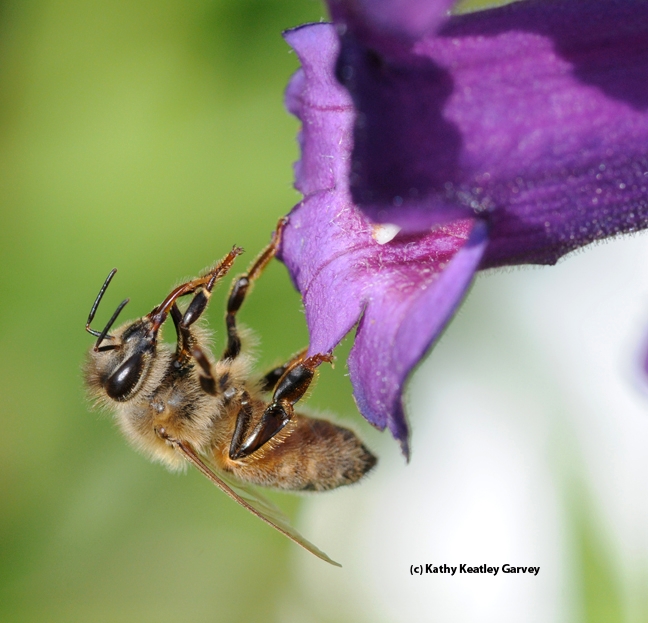
But have you ever seen a honey bee cleaning her tongue?
Bay Nature contributing editor Alison Hawks recently asked two of our UC Davis bee experts why bees clean themselves. Their joint answer is posted on the Bay Nature website under "Ask a Naturalist." Bay Nature, as you've probably surmised, is based in the Bay Area--Berkeley, in fact. It explores nature in the San Francisco Bay Area.
Answering Bay Nature's question were Extension apiculturist emeritus Eric Mussen, who retired in June of 2014 after 38 years of service, and new Extension apiculturist Elina Lastro Niño.
Mussen continues to maintain an office in Briggs Hall, while Niño is based at Briggs and at the Harry H. Laidlaw Jr. Honey Bee Research Facility on Bee Biology Road, west of the central campus.
The Question:
Ask The Naturalist: Why Do Honeybees Clean Themselves?
The Answer:
"The inside of a bee hive is considered to be a pretty clean environment. The bees produce honey there and we eat it. But, why are honey bees and their hive so clean? It is in their genes.
"Honey bees are akin to animated robots that move around in their environment responding to stimuli with behaviors that have served them well for millions of years. Building wax combs to use for food storage and baby bee production allows the bees to keep tens of thousands of bees huddled close together. However, if any type of microbial outbreak occurs, all this closeness could lead to an epidemic and colony death.

"As for the bees themselves, it is common to see them using their legs or mouthparts to clean off other parts of their bodies. For bees, we might think that they are simply moving around or brushing off pollen that they picked up when foraging. However, honey bees live in a suit of armor called an exoskeleton. The exoskeleton is waterproof and protects the insects from invasive microbes. But bees also have to sense what is going on around them, so they have sensory receptors on the surface of their exoskeleton. The most obvious sensory organs on bees are their compound eyes. Honey bees can see objects, detect polarized sunlight, and have good color discrimination, similar to that of humans, but shifted a bit in the color spectrum. Bees wipe their eyes every so often to keep them clean. We humans have eye lids that keep our eyes clean and moist.
"The rest of the sensory organs on the exoskeleton are sensilla (stiff hairs and protuberances) or pits that serve as sensory receptors. The tips of honey bees' antennae have many touch receptors, odor receptors, and a special sensory organ called Johnston's organ that tells them how fast they are flying. Other sensilla bend when the bee changes positions, so it remains aligned with gravity when it is building comb cells. Sensilla on a queen bee's antennae help her determine the size of a comb cell, which determines if she lays a worker- or drone-destined egg. So, all those sensilla must remain dust and pollen-free to function properly, allowing bees to remain as busy as, well, bees."
So, there you have it--why bees clean themselves. Great information! Thanks, bee experts and Bay Nature!
Attached Images:
